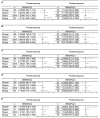Menopausal Impact on the Association Between Thyroid Dysfunction and Lipid Profiles: A Cross-Sectional Study
- PMID: 35360082
- PMCID: PMC8964097
- DOI: 10.3389/fendo.2022.853889
Menopausal Impact on the Association Between Thyroid Dysfunction and Lipid Profiles: A Cross-Sectional Study
Abstract
Background: Both dyslipidemia and thyroid dysfunction have a high prevalence rate and are important risk factors for cardiovascular diseases. However, the relationship between blood lipids and thyroid dysfunction is still controversial. This study aims to analyze the blood lipids in people with different thyroid functions.
Methods: A total of 80937 adults were included in this population-based cross-sectional TIDE survey, which collected demographic and clinical data on thyroid function, blood lipid levels and other metabolic indicators. After screening, the final analysis included 10,747 participants, who were divided into hypothyroidism (n=311), subclinical hypothyroidism (n=5015), hyperthyroidism (n=203), subclinical hyperthyroidism (n=118) and control (n=5100) groups. The risk of dyslipidemia was analyzed by a logistic regression model and divided into groups of female menopausal.
Results: After full adjustment, significant associations were found between hypothyroidism and hypertriglyceridemia. Subclinical hypothyroidism was associated with a significantly higher risk of hypertriglyceridemia and hyper-low density lipoprotein cholesterolemia. Hyperthyroidism was significantly correlated with a reduced risk of hypercholesterolemia and hyper-low density lipoprotein cholesterolemia but positively correlated with the risk of low-high density lipoprotein cholesterolemia. There was no significant association between subclinical hyperthyroidism and blood lipids. Hypothyroidism increased the risk of hypertriglyceridemia in both premenopausal and postmenopausal females. Subclinical hypothyroidism was significantly associated with increased hypertriglyceridemia and low-high density lipoprotein cholesterolemia in premenopausal females. Hyperthyroidism was significantly associated with a reduced risk of hypercholesterolemia and hyper-low density lipoprotein cholesterolemia in premenopausal females and an increased risk of low-high density lipoprotein cholesterolemia in postmenopausal female.
Conclusion: Abnormal thyroid function has an important effect on blood lipids and is closely related to female menopause.
Keywords: blood lipids; dyslipidemia; hypercholesterolemia; menopause; subclinical hypothyroidism; thyroid function.
Copyright © 2022 Han, Wang, Zhang, Zhu, Zhu, Li, Teng, Teng and Shan.
Conflict of interest statement
The authors declare that the research was conducted in the absence of any commercial or financial relationships that could be construed as a potential conflict of interest.
Figures



Similar articles
-
Treatment of Thyroid Dysfunction and Serum Lipids: A Systematic Review and Meta-analysis.J Clin Endocrinol Metab. 2020 Dec 1;105(12):dgaa672. doi: 10.1210/clinem/dgaa672. J Clin Endocrinol Metab. 2020. PMID: 32954428
-
The Relationship Between Thyroid Function and Metabolic Syndrome and Its Components: A Cross-Sectional Study in a Chinese Population.Front Endocrinol (Lausanne). 2021 Mar 31;12:661160. doi: 10.3389/fendo.2021.661160. eCollection 2021. Front Endocrinol (Lausanne). 2021. PMID: 33868183 Free PMC article.
-
A comparative study on serum lipid levels in patients with thyroid dysfunction: a single-center experience in Ethiopia.BMC Endocr Disord. 2025 Feb 20;25(1):47. doi: 10.1186/s12902-025-01851-1. BMC Endocr Disord. 2025. PMID: 39979947 Free PMC article.
-
Associations between subclinical thyroid disease and metabolic syndrome.Endocr J. 2012;59(10):911-7. doi: 10.1507/endocrj.ej12-0076. Epub 2012 Jul 5. Endocr J. 2012. PMID: 22785370
-
The effect of thyroid dysfunction on breast cancer risk: an updated meta-analysis.Endocr Relat Cancer. 2022 Dec 12;30(1):e220155. doi: 10.1530/ERC-22-0155. Print 2023 Jan 1. Endocr Relat Cancer. 2022. PMID: 36256851 Review.
Cited by
-
Prevalence and Risk Factors of Subclinical Hypothyroidism in Young and Middle-Aged Patients With First-Episode Drug-Naïve Major Depressive Disorder.Depress Anxiety. 2025 Apr 16;2025:3154096. doi: 10.1155/da/3154096. eCollection 2025. Depress Anxiety. 2025. PMID: 40270696 Free PMC article.
-
Hypothyroidism, lipids, and lipidomics.Endocrine. 2024 May;84(2):293-300. doi: 10.1007/s12020-023-03420-9. Epub 2023 Jun 17. Endocrine. 2024. PMID: 37329413 Free PMC article. Review.
-
Effects of key physiological parameters on cardiovascular disease and osteoporosis risk in perimenopausal and postmenopausal women.Sci Rep. 2025 Jan 22;15(1):2814. doi: 10.1038/s41598-025-86613-8. Sci Rep. 2025. PMID: 39843604 Free PMC article.
-
Hypothyroidism correlates with osteoporosis: potential involvement of lipid mediators.Front Med (Lausanne). 2024 Nov 1;11:1453502. doi: 10.3389/fmed.2024.1453502. eCollection 2024. Front Med (Lausanne). 2024. PMID: 39554507 Free PMC article.
-
Development and validation of a nomogram for predicting immune-related thyroid dysfunction during immunotherapy in non-small cell lung cancer: a prospective cohort study in China.Front Immunol. 2025 Jul 25;16:1611956. doi: 10.3389/fimmu.2025.1611956. eCollection 2025. Front Immunol. 2025. PMID: 40787465 Free PMC article.
References
-
- Sigal GA, Tavoni TM, Silva BMO, Kalil Filho R, Brandão LG, Maranhão RC, et al. . Effects of Short-Term Hypothyroidism on the Lipid Transfer to High-Density Lipoprotein and Other Parameters Related to Lipoprotein Metabolism in Patients Submitted to Thyroidectomy for Thyroid Cancer. Thyroid (2019) 29:53–8. doi: 10.1089/thy.2018.0190 - DOI - PubMed
-
- Bell RJ, Davison SL, Topliss DJ, Donath S, Davis SR, Rivera-Woll L, et al. . Well-Being, Health-Related Quality of Life and Cardiovascular Disease Risk Profile in Women With Subclinical Thyroid Disease? A Community-Based Study. Clin Endocrinol (2007) 66:548–56. doi: 10.1111/j.1365-2265.2007.02771.x - DOI - PubMed
MeSH terms
Substances
LinkOut - more resources
Full Text Sources
Medical

